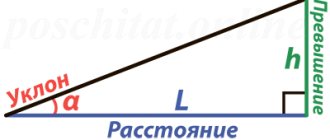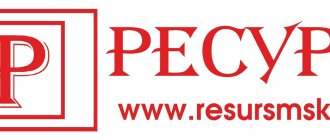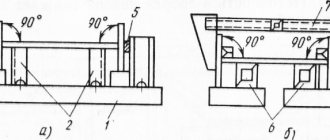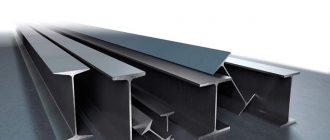Installation of metal structures. Cost in estimate
The prices in the estimate for the installation of metal structures, the prices in the estimate for the dismantling of metal structures and the prices in the estimate for the manufacture of metal structures are closely related to each other, so it is not surprising that the use of this type of prices is often a standard set for an estimate in form No. 4, a local estimate or a local resource estimate calculation.
It should be said right away that most of the prices for the manufacture of metal structures, as well as prices for the installation of metal structures, are included in the estimate form based on the collection 09 of the estimate normative bases GESN or FER. Only, it is obvious that if the estimate is prepared using the base-index method at the basic price level, then the base for choosing prices for the installation of metal structures is FER. If the estimate is made at current prices, then GESN are used for the installation of metal structures.
The use of prices in estimates for the manufacture and installation of metal structures occurs not only when drawing up estimate forms directly when working with metal structures. Estimates for the installation of metal structures can also be drawn up for such types of construction as the construction of residential and industrial buildings, the installation of heating networks, water supply, sewerage, installation of power lines, etc. Thus, as we see, the installation and production of metal structures in FER or GESN can be used in the production of various, and sometimes related, construction works.
In addition, an estimate for the dismantling of metal structures or a sample estimate for the production of metal structures may also include additional work with metal, without which it is not possible to successfully commission the construction project. Such additional, but mandatory for use, may be prices in the estimate for painting metal structures, prices in the estimate for welding work on metal structures, prices in the estimate for fire protection of metal structures or prices in the estimate for assembling metal structures. It should also be noted that the list of such prices can be expanded depending on the requirements of the design documentation and the rules for performing work with metal structures.
As noted above, most of the prices in the estimate for metal structures are applied on the basis of the collections GESN 09 or FER 09, which are part of the construction part of the regulatory framework. As shown in Figure 1, Collection 09 includes a fairly wide range of standards that can be included in the estimate for the manufacture of metal structures or in the estimate for welding work of metal structures. The collection contains prices for the manufacture of metal structures of buildings and structures, and prices for the installation of metal fencing structures or special-purpose structures. Sometimes you can hear about the use of prices for the manufacture of metal structures from GESN 38 or standards for the manufacture of metal structures FERm 38. It should be said right away that these expressions are incorrect, since the collection 38 of the construction part is designed for masonry structures of hydraulic structures, and the collection FERm 38 does not exist at this time moment.
Figure 1. Composition of the collection GESN09
What is the difference between an estimate and a calculation?
As mentioned above, estimates and calculations serve one purpose, namely, calculating the cost of constructing an object as a whole, or only some part of it or type of work. An estimate is the most common form of calculating the cost of an object, and a cost estimate is prepared much less frequently, as a rule, in exceptional cases. So what is the difference between an estimate and a cost estimate? The difference between a cost estimate and a cost estimate mainly lies in the fact that when preparing a cost estimate, the cost of a particular type of work is calculated, and when calculating estimate forms, the total cost of the work is calculated, which can also include amounts from the estimates. Although, of course, this is not a universal answer to the question of how calculation differs from an estimate. After all, there are also cases when calculations can include entire complexes of work that are in no way inferior in their completeness and accuracy to the estimated prices applied using the regulatory frameworks of GESN and FER. In fact, in such cases, the calculation is an estimate and serves as a completely acceptable justification for the contract price.
Another difference between an estimate and a calculation is that estimate forms (local estimate, local resource estimate, estimate according to form No. 4, etc.) are most often drawn up on the basis of estimate regulatory frameworks FER, TER, GESN, OER, etc. .d. And an estimate calculation is a form that is compiled mainly using single norms and ENR prices. Such an explanation can also become a description in simple words of how an estimate differs from a cost estimate. Of course, such statements are a simplified way of explaining how costing differs from cost estimates, and in reality the preparation of both cost estimates and estimates will be complicated by many factors.
In addition, difficulties may also be caused by the fact that at the moment there is no unified form of costing, so it is not possible to provide a universal sample for compiling work costing. This is due to the fact that in each specific case of the need to prepare a cost estimate, the specialist drawing up this type of document will need to refer to various sources and data. Although it should be noted that sometimes a sample cost estimate for work is part of the appendices to the contract. Below we will consider some examples of costing of work to more clearly explain the principles of drawing up this type of documentation.
GESN for the production of metal structures for building frames
The first section of the GESN09 collection, as can be seen in Figure 1, is a set of standards for metal structures of buildings and frames. Using the standards from this section, you can understand how to evaluate the manufacture of metal structures of one-story and multi-story industrial buildings, special-purpose structures or frames from light metal structures. All listed types of structures are divided into subsections.
Subsection 1.1 contains estimated prices for the manufacture of metal structures and their installation in buildings. Using the standards from this subsection, you can draw up an example of an estimate for the manufacture and installation of metal structures for the frames of single-span or multi-span buildings, frames of prefabricated single-story or multi-story buildings.
Subsection 1.2 is designed for drawing up cost estimates for the installation of frames for waste incineration plants, engine rooms, boiler rooms, steelmaking shops, etc. Subsection 1.3 can be used when applying prices in the estimate for the manufacture of metal structures for pavilion frames.
Two formulas. Calculation in Excel.
To perform the calculation in Excel, you must specify the overall dimensions of the building and the number of floors.
The calculation is performed using two different empirical methods. First, the specific consumption per unit area of one floor , and then the total mass of the building frame made of metal structures is determined.
g 1 =( 0.12+m/200)*H/m*1000/9.81
G1=g1*L*B*m
g 2 =9.5* m 0.39 * H / m
G 2 = g 2 * L * B * m
Prices in the estimate for the installation of metal structures of buildings and structural elements
Section 2 of the collection 9 of the construction part of GESN or FER contains standards for metal structures of various structures. By the way, this collection, as a rule, is present not only in the collections of GESN or FER, but you can also find prices for the manufacture of metal structures in the TER of the region of the country in which the construction of a specific facility is taking place.
In this section, as can be seen in Figure 2, prices are for the installation of bunkers, galleries, and shafts. In the section you can find standards not only for the installation of metal structures themselves, but also prices for the protection of bunkers, for cargo tests, and others. The standards of this section can also be applied when drawing up an example estimate for the construction of a warehouse made of metal structures, because the tables of subsection 2.5 take into account the installation work of both warehouse frames and enclosing elements in the production of mineral fertilizers.
Figure 2. Composition of section 2 in the collection GESN09
Section 3 is usually taken into account in the example of estimates for the manufacture of metal structures and their installation during the installation of base plates, installation of lanterns and metal arches, as well as during installation work of floors, metal baseboards, etc. These types of prices also exist in the ninth collection of TER for the installation of metal structures. It should be noted that most of the standards from the 9th collection have a unit of measurement in tons, that is, the volume of work is measured by the weight of the installed metal structures.
Section 4 of this building collection contains standards for installation work of various enclosing structures. If it is necessary to reflect in the estimate the installation of fire hatches, window units, shop windows, metal doors, then it is most advisable to use this section. Also, a sample estimate for the manufacture of metal structures and their installation may contain the standard from table GESN09-04-013, which takes into account the installation of fire doors.
Prices for welding metal structures in the estimate
GESN standards for welding metal structures are often used not only in estimates for the installation of various metal elements and structures, for example, in estimates for the manufacture of a canopy from metal structures. Prices for welding metal structures can be part of a sample estimate for the dismantling of indoor metal structures or estimate forms for other specialized construction work.
When drawing up estimates for welding metal structures, it is recommended to use the standards of section 09 of the collection of the GESN and FER databases. Figure 3 shows table GESN09-05-002, the standards of which can be used when drawing up sample estimates for welding work on metal structures. As you can see, this table includes four types of norms. Standard GESN09-05-002-01 is designed for welding during installation of frames. The standards GESN09-05-002-02 and GESN09-05-002-03 can be used as prices in estimates for welding metal structures of supporting parts and coatings. And the standard coded GESN09-05-002-04 can be applied when drawing up estimate forms for metal beams and trusses.
Figure 3. Table GESN09-05-002
Calculation of metal structures in relation to their efficiency
The opinion that the smaller the dimensions and weight of rolled metal, the more profitable the design will be from it, is erroneous. It is easy to guess that thinner corners will withstand less load, and this is true for any materials made of steel or cast iron. Therefore, quite a lot of basic criteria for determining the efficiency of a product, be it an I-beam or a channel, are used. In particular, the ordinary and plastic moment of resistance (W and Wп, respectively), the moment of inertia I, the radius of gyration i and the shear resistance of the cross section Cc. It is based on all these parameters that the most advantageous form of the product is determined.
For special cases, it is more logical to use a value such as the specific cross-sectional area of the profile, which is denoted as Aw and is determined by the formula Aw = A/W2/3 . Here A is the cross-sectional area of the profile, or, in other words, a given amount of material, and W is the moment of resistance equal to unity. Comparing various structural elements and having indicators N = N1 , which can express any of the characteristics of the material (W, Wп, I, I or Cc), we still do not always get identical profiles. Therefore, it is necessary to carry out calculations of metal structures using the formula for determining the relative efficiency of one material relative to another: Δ = (F/F1 – 1) . 100% , the calculation result is expressed as a percentage. Here F and F1 can mean the mass or cost of a certain unit of length or the entire rolled metal product, as well as the cross-sectional area.
Other work when preparing estimates for metal structures
One should not lose sight of the fact that in Section 5, in addition to prices for welding metal structures, there are standards for other work. For example, from the contents of the section it is possible to select prices in the estimate for cutting metal structures. For example, the norm under the code GESN09-05-006-01 can be used to determine the cost of cutting corrugated sheets, and the norms in the table GESN09-05-007 can be used for cutting holes.
In addition, Section 5 also contains standards for ultrasonic testing, quality control of welds, installation of bolts, as well as standards for cladding gates with corrugated sheets.
When applying prices from the Grand Estimate for the manufacture of metal structures, you can also use prices from sections 6, 7, 8 of the 09 collection, of course, provided that the construction project corresponds to the construction project in these sections. Thus, section 6 can be applied to metal structures for special purposes. Such structures include cable cars, stage devices, industrial ovens, cooling towers, etc.
The standards of Section 7 are suitable when drawing up estimates for metal structures of nuclear power plants. Using this section, you can evaluate the installation and production of protective shells for nuclear power plants, anti-corrosion protection, etc.
The prices in the estimate for the installation of metal structures of various protective structures are applied on the basis of Section 8. The standards of this section will be relevant when drawing up an estimate in Form No. 4, a local resource estimate or a local estimate for the installation of metal poles, barriers, barriers, etc.
Also, some prices for the manufacture and installation of metal structures may be included in 46 of the construction collection for reconstruction. For example, section 7 of this collection is designed to replace metal structures of tanks and various structures, and in section 1 you can find prices for strengthening metal beams, trusses, crossbars, etc.
Also, the norms of Collection 46 can be used when applying prices in estimates for the installation of small metal structures, for example, when drawing up estimates for installing a canopy made of metal structures. Thus, the standard coded GESN46-05-008-03 provides for the installation of small structures weighing up to 10 kg. The work of this standard includes welding, cutting and cleaning of the assembled metal structure. The volume of work is measured in tons.
If it is necessary to use more specialized calculations, for example, on the turnover of metal structures of supports for estimates, you should refer to the regulatory documents for this type of calculation.
Prices for dismantling metal structures in the estimate
There are several pricing options for dismantling metal structures in the regulatory framework. In this case, a sample estimate for the dismantling of metal structures can be drawn up either using FER prices for the dismantling of metal structures, or include the dismantling of metal structures according to GESN. This will depend on the price level and by what method the estimate form should be drawn up.
Most often, if there is a need to use prices in the estimate for dismantling metal structures, it is possible to use special reference books for dismantling work. In these reference books there are coefficients for the dismantling of metal structures, among other things.
In addition, prices for dismantling metal structures can be applied from the collections of the repair and construction part of GESN and FER. In this case, the standards should be selected based on the design data of the facility. That is, if the project involves the dismantling of steel floor beams, then it is most logical to look for a price for this type of work in the collection GESNr54 called “Overlap”, and in the collection GESNr59 you can find a price for dismantling metal stairs. Collections of the repair and construction part of the regulatory framework can also be used when searching for prices in estimates for the repair of metal structures.









